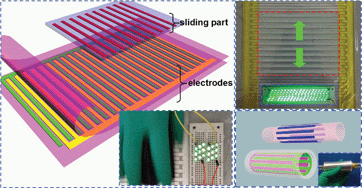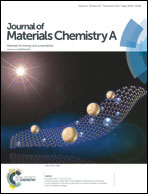Flexible interdigital-electrodes-based triboelectric generators for harvesting sliding and rotating mechanical energy†
Abstract
Triboelectric generators have attracted considerable attention due to their rapidly improved electromechanical conversion efficiency. It is a great challenge to design a triboelectric generator to enable practical and effective operations. In this paper, we present a flexible interdigital-electrodes-based triboelectric generator (FITG) for harvesting sliding and rotating mechanical energy. When a film of flexible interdigital electrodes is placed on a plane, it can be used for harvesting sliding energy. When the film of the flexible interdigital electrodes is rolled into a cylinder, it can be used for harvesting rotating energy. In sliding mode, the maximum open-circuit voltage, short-circuit current and peak power density reach up to 400 V, 120 μA (10 mA m−2) and 13 W m−2, respectively, under a sliding velocity of 3.95 m s−1, which can be used to light tens of light-emitting diodes (LEDs) and to charge a commercial capacitor to 7.2 V within 35 s. The FITG can harvest the mechanical energy of mouse operation and traditional printing. In rotating mode, the maximum output voltage of the generator reaches as high as 1020 V at a rotating speed of 240 rpm. The FITG with interdigital electrodes on a flexible substrate has the advantages of light weight, resistance to wear, multifunction and high output power.



 Please wait while we load your content...
Please wait while we load your content...